Intel's 925X & LGA-775: Are Prescott 3.6 and PCI Express Graphics any Faster?
by Anand Lal Shimpi on June 21, 2004 12:05 PM EST- Posted in
- CPUs
LGA-775: Do we really need it?
The hot topic at Computex this year was Intel's new 775-pin LGA socket. Motherboard and memory manufacturers alike were complaining left and right about reliability issues with Intel's new socket, and with the launch less than a month away, we were obviously concerned as well.
First, why even bother with a new socket/interface? The Pentium 4 was doing just fine on Socket-478, and now with LGA-775, we're able to get another 200MHz? Seems silly, no?
While it's true that LGA-775 isn't necessary today, there are a couple of factors that dictate its necessity for tomorrow. As we've talked about before, a CPU's package can actually be a limiting factor when it comes to core clock speed as well as FSB frequency. Think about it this way; today's Pentium 4s run at a 800MHz FSB, meaning that the interface between the CPU and the chipset has to be capable of handling 800MHz signaling across a wide 64-bit bus. When we talk about the interface between the CPU and the chipset, physically, what are we talking about? We are talking about the traces on the motherboard going from the chipset to the CPU socket, the CPU socket itself and the pins on the CPU. Improvements in the pin interface are necessary in order to allow for higher FSB CPUs. While today's 800MHz FSB isn't really pushing the limits, remember that Prescott's replacement will be paired up with a 1.2GHz FSB.
The LGA-775 interface also packs the pins closer together, allowing 775 pins to exist in about the same space that 478 pins did on the old package. More tightly packed pins mean that we're dealing with shorter routes from the CPU's core to the external interface itself, also a desirable trait.
With more pins, we also have the ability to deliver more power, more reliably than before - which will also come in handy as Prescott and its successor ramp up to 5GHz. Intel banked quite heavily on clock speed with their NetBurst architecture, and part of the commitment was a commitment to new packaging technologies.
The other change that LGA-775 makes, and clearly the most controversial one, was to move the pins off of the CPU itself and onto the motherboard - meaning that the CPU itself is mostly flat underneath. The capacitors on the bottom of the CPU keep it from becoming perfectly flat, but the lack of pins definitely make it a flatter chip.
With no pins on the CPU, the first thing that should pop into your head is - "woohoo, no bent pins on your CPU." Unfortunately, with the pins on the motherboard, now you can have bent pins on your motherboard - and with the LGA-755 interface, they are much easier to bend, and much more difficult to unbend.
The problem with the LGA-775 socket is that you can't see the pins in the socket very well when you've got the CPU suspended in air above it. You have to be very gentle and very precise when placing the CPU on top of the pins because if you drop it on the pins or if you are just one pin off, you risk bending a lot of pins.
Although we haven't tried it yet, Intel has told us that once you bend a number of the pins on the socket itself, in essence, it's pretty much impossible to unbend them. Remember that we're talking about 775 very fragile pins in that socket - and we thought Socket-478 was bad.
There was another significant change in the socket structure with LGA-775: the locking lever. It used to be that the heatsink, not the socket's lever, was what provided the majority of force on the CPU itself to ensure secure installation in the socket (to prevent against package pullout and to guard against shearing the mechanical attach between socket and motherboard as well as the chipset and motherboard). Unfortunately, that meant that the heatsink had to supply upwards of 40 lbs of force to the CPU, which caused a lot of issues, the biggest of which was bending motherboards.
While Intel insists that the amount of bending caused by their heatsinks on Socket-478 motherboards was within tolerances, the fact of the matter is that with enough heatsink installations and removals, you could do some serious trace damage to your motherboard, thanks to the bending of the board.
With LGA-775, Intel has addressed the pressure problem and now it's the socket lever and not the heatsink that supplies the ~40 lbs of force to not only secure the chip but also make adequate contact between the CPU and the pins. The heatsink now has to provide much less force and thus, doesn't bend the motherboard as much.

The old heatsink used to bend the motherboard quite a bit...
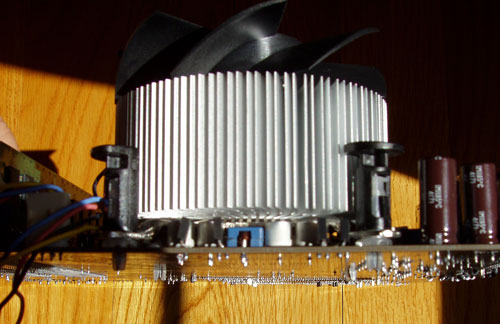
...but the new heatsink doesn't do so, not as much at least.
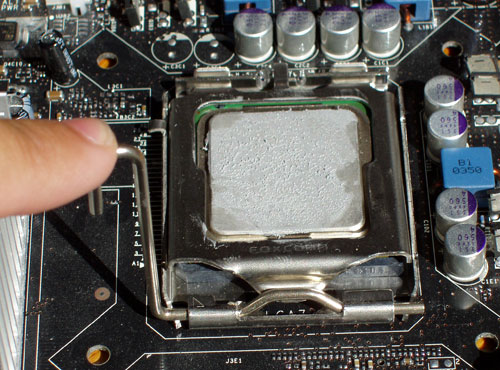
The socket's lever requires more force to engage, but it also puts much more force on the CPU than in the old socket.
Intel's new heatsink is actually a huge improvement over their old ones, thanks to the removal of heavy-duty downforce as one of its job requirements.
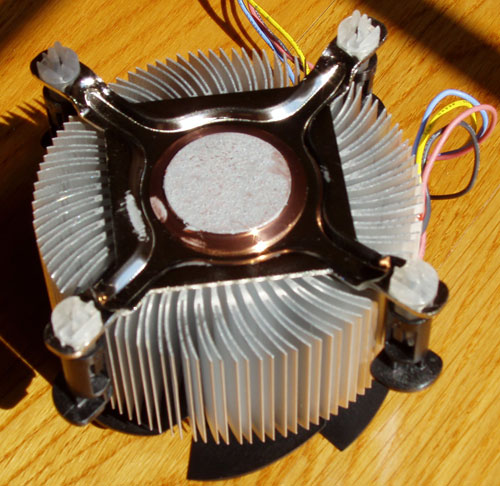
The four pegs of the heatsink basically plug into the holes in the motherboard, and you twist the tops of the pegs to have it locked. You have to make certain to twist the pegs securely; otherwise, the heatsink has a tendency to pop off. Luckily, Intel's thermal throttling prevents any serious damage from occurring as a result.
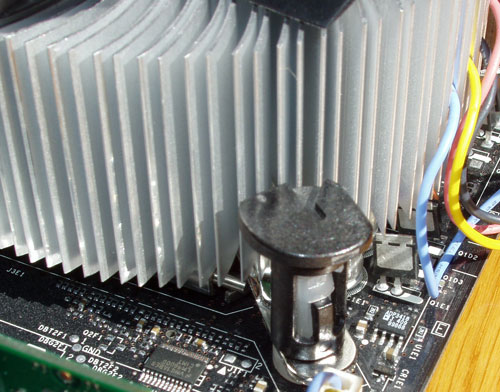
The bottom line is that a new CPU socket was necessary to continue with Intel's future CPU plans, but the fragility of LGA-775 definitely shows that Intel didn't take enthusiast users into consideration. Intel has neglected the enthusiast community in the past, and although we do make up a very small portion of the overall computing community, it's still an important group on which to focus. If you buy an LGA-775 board, just be very careful. We haven't had any problems yet, but we've been extremely careful with our installations.
It looks like LGA-775 will take us to the end of the Pentium 4 line, although we would have liked a more user-friendly socket to keep us company over the next couple of years.


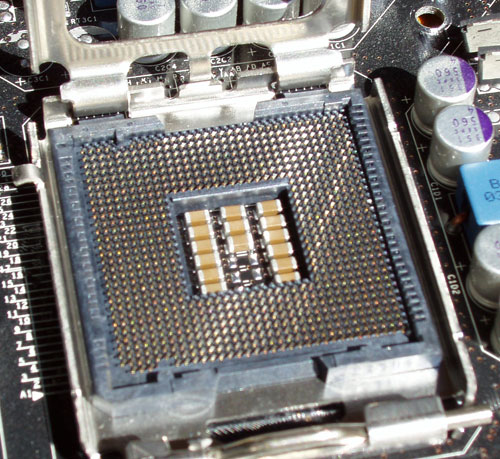
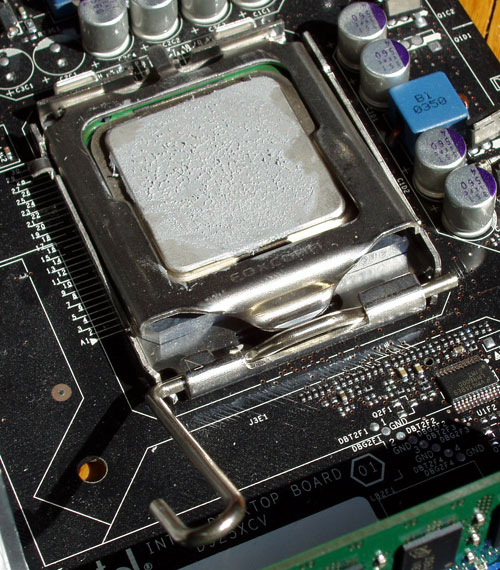
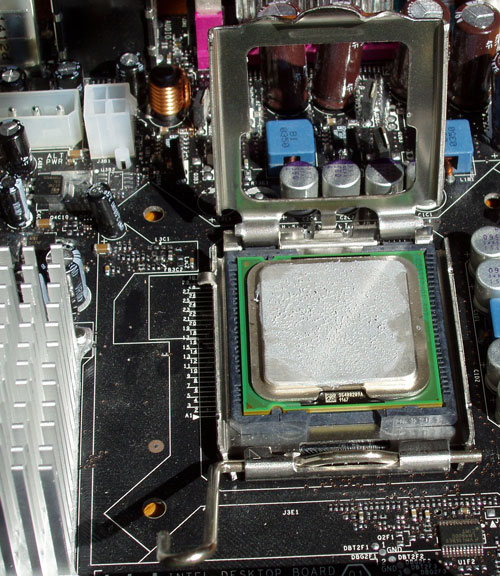








39 Comments
View All Comments
khirareq - Friday, April 1, 2005 - link
Um, sorry, but i feel that i need to point something outYou state a number of times that the pins need to be twisted in order to secure the HSF - If you read the leaflet thats included with the CPU, it staes that the Pins are twisted in order to relase the HSF for removal
Intels Manual DOwnload (>10meg):
http://support.intel.com/support/processors/sb/CS-...
Screenshot of the page:
http://photobucket.com/albums/v337/khirareq/?actio...
I discovered this at work the other night after spending some time trying to work out how to remove one, and resigned to reading the manual (turn out the HSF was faulty and jammed in the board anyways)
Pete - Tuesday, June 29, 2004 - link
Anand, not to get too confrontational, but have I offended you in such a way that you choose not to reply to my questions? I'm not sure why my surprise at the 6800U's gains in Far Cry aren't worth remarking on.I'd appreciate an answer. If you take exception to my questioning your numbers, I'd be satisfied with a reply to that effect, and I'd readily apologize if I've offended you with my perhaps overly blunt questioning.
justly - Sunday, June 27, 2004 - link
Anand, thank you for the response, and for the effort you put forth in getting it.A few (minor) questions could still be asked about mechanical stability, but it is much more believable than the electrical issue.
Again, thank you.
Anand Lal Shimpi - Friday, June 25, 2004 - link
justlyAs promised, I got together with Intel to talk about their statement. Intel has revised their statement and instead state that the ~40 lbs of pressure is used for mechanical stability and not for the stability of the electrical connections - good call :)
As you already mentioned, LGA-775 is a different story since it needs the pressure to keep the contact with the pins. Apparently the heatsink doesn't need to apply as much pressure as before since the mechanical stability isn't an issue with LGA-775.
So in the end it wasn't a heat transfer issue or an electrical issue, purely mechanical.
I've made the appropriate corrections to the piece.
Take care,
Anand
Pete - Tuesday, June 22, 2004 - link
Hi Anand,Any comment re: my previous post on the 6800U Far Cry numbers? Just checking if they're right. Thanks.
Cygni - Tuesday, June 22, 2004 - link
Ive actually discussed Prescott a little with a designer at Intel's Folsom facility (although this person worked on the Granite Bay chipset and then some Centrino work). He cant really figure out the chip either, but he believes that the entire purpose of Prescott hasnt been taken out from under wraps yet. Possibly mechanisims to combat the problems with increases in clock speed etc... things that are on the core, just not activated (ala HT). I guess we will see. Maybe the purpose of Prescott is to ready technologies and proccesses to combat Hammer's successor when it appears? Neither of us were sure.stephenbrooks - Tuesday, June 22, 2004 - link
Those software compilation scores do not look pretty for Intel. Looks like they'll be approaching 5GHz before a Prescott-like processor will beat even an FX-53! 8-\ New CPU core, please...araczynski - Tuesday, June 22, 2004 - link
very nice article, like the depth.sounds like the bottom line (for my tastes) is to get the 6800U and forget the intel line for another year.
Anand Lal Shimpi - Tuesday, June 22, 2004 - link
ThePlagiarmasterSorry, I completely forgot to post my reply to your post :)
We started using Gordion Knot because that's what we found was most recommended for high quality DivX ripping. Instead of just benchmarking every codec/ripping tool for our CPU reviews, what I'd rather do is compare all of the codecs/tools and figure out which one truly offers the best quality - then it's the performance using that configuration that matters. After all, who cares if AMD or Intel is faster if it's on an application that no one actually uses; that's not the point of a real world benchmark.
Give us time, and we will not disappoint. I've already talked to Derek about doing such an article, but now I think I'm going to push up its priority a bit.
Take care,
Anand
ThePlagiarmaster - Tuesday, June 22, 2004 - link
Anand.I take it no comment means you're off benchmarking dvd2avi for a divx showdown?? :)
Pumpkinierre,
You're welcome :) Hopefully we'll get some benchmarks here, proving once and for all who's rules the divx roost. At least Anand's users would be more informed in the end. For anyone interested LOOK HERE:
http://www.hardocp.com/article.html?art=NjMwLDU=
Looks like a 20% victory for AMD64 in Divx (dvd2avi). A quick look lower on the page shows Intel(3.6ghz 3.4EE) with about the same 20% victory in Divx(Xmpeg frontend). Perhaps Anand can end it all by testing one against the other?
Maybe a whole article could be done on this? With say, Ripping to Divx, Ripping R9 Retail to DVD5 (CCE/Tmpeg etc?), Ripping MP3's etc. I'm sure there are more CPU intesive ideas, but the point is finding the best app to do the same job on both platforms. Rather than a blanket statement like 'intel is better than amd at divx' when it's not clear that's true. Not with so many frontends to choose from that do the same job, and CLEARLY they perform DRASTICALLY different on each cpu (amd/intel). With games it's cut and dried (no frontends, just the game itself), but apps are a different story.
Plag